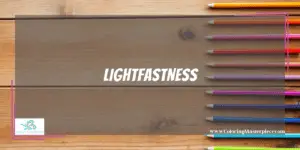Whether you are new to coloring or a seasoned artist, the names Polychromos and Prismacolor are likely to catch your attention. These are two of the most popular colored pencils brands out there, and they are often compared head to head.
Construction

Right off the bat, Polychromos come out on top for the construction of the pencils. The oil-based cores on Polychromos are glued to the cedar wood casing, ensuring the safety of the lead throughout the entire pencil. By doing this the lead is far less likely to break if the pencil is dropped. The harder core also allows Polychromos pencils to be sharpened to a finer point, and they hold this point much longer than the softer Prismacolor leads. Prismacolor cores are wax-based, meaning they draw smoother but also dull faster. Prismacolors are notorious for breaking in the cases and as you sharpen the pencil. The lead is not glued to the casing, so it has more room to move around and break if dropped.
Color Variation
When it comes to the variety of colors you can find Prismacolors are the better choice. Prismacolor Premiers have a total of 150 colors that you can work with, while Polychromos only have 120. Both brands sell these colors in sets ranging from as few as 12 to ones that include every color available. The range of Prismacolor pencils is also preferred by most artists. On top of having 30 extra opportunities for new colors, there is a better balance between bright and muted tones. Each color is just as vibrant as it is on the casing, and you can create a creamy base in no time. Polychromos pencils also create vibrant colors that match their casing well, but layering takes a bit more work. You also have less variety within what is offered by Polychromos, and you will find darker shades in the sets.
The White Pencil
A white colored pencil is a great tool for adding highlights to your work, but it needs to meet certain criteria to be effective.
White-colored pencils should be:
- True white
- Opaque
- Consistent
While the Polychromos pencil might be better suited to thin highlights or details where the Prismacolor will not hold its point, the Prismacolor is more opaque and consistently white.
Layering
Polychromos are generally better for layering, especially with multiple colors, but both colored pencils perform well here. The key with Polychromos is using light layers. As long as you are putting in the work to blend the layers you will have a more seamless blend. Switching up your technique can also influence the end appearance of the colors.
Prismacolors are great at laying down a smooth layer, but they can be difficult to blend after a certain point. This is due to the nature of wax-based colored pencils and the inevitable limit of wax on the page. Prismacolors are also prone to wax blooming. This issue can be addressed by wiping it off with a soft cloth, but it limits the work you can do layering on the page. Polychromos are not bound by any such limit, and you can layer almost endlessly.
Blending
When it comes to blending it depends on what you want from the pencils. If you are looking to blend many colors to create a unique, multi-faceted hue then Polychromos are the better choice. Because they have nearly unlimited layering potential, you can add as many colors to the blend as needed.
While oil-based colored pencils can be more difficult to blend, the medium-hard core of a Polychromos colored pencil does not seem to have as much difficulty. You may need to use a solvent to move the pigment on the page, but burnishing is usually enough to get the job done.
Prismacolors have a soft core that is easy to manipulate, making these colored pencils a dream to blend. You cannot use as many colors as you would with Polychromos, but Prismacolors can achieve a rich blend with less effort. They are also easier to lighten as needed.
Prismacolors will hit a point where you cannot blend the colors anymore because there is too much wax to allow new pigment in. At this point, you can use a solvent to blend the colors without adding any more wax, but you will not be able to add another pigment at this stage.
Learn about advanced techniques you could be using in your coloring!
Erasing
While Polychromos pencils have a harder core, they are the easier option to erase. This is because the friction of the eraser can more easily remove the hard pigment on the page. With Prismacolor pencils, the wax resists friction used when erasing. You are more likely to smudge the color than to erase it, so removing any mistakes with Prismacolors involves more work.
To erase Prismacolor you can try breaking up the wax with a solvent and using an absorbent material, like cotton cloth, to remove it from the page. Even with this method, you are unlikely to remove as much of the color, and you risk damaging the page.
Lightfastness

The lightfastness of colored pencils is not a big deal unless you intend to sell your work or you want to ensure it will last a longer period. Most amateur or hobby colorers do not bother investing in lightfastness, but this is a key area of difference between Polychromos and Prismacolor pencils.
Polychromos colored pencils are the only option here if you intend to sell your work, and looking at their lightfast ratings explains why. The majority of Polychromos colors (102 of the 120) are rated for maximum lightfastness, meaning that they are capable of resisting fading for more than a century.
While many Prismacolor pencils have a lightfast rating, they achieve this at a much lower level. Prismacolor pencils are great for showing off vibrancy at the moment, but they are not capable of lasting decades or intense situations.
Price and Quality
At first glance, Prismacolor pencils will always be cheaper than Polychromos pencils, but there is a stark difference in the quality of the two brands. Polychromos pencils are built more intentionally. Looking back at their sturdier construction and taking the more expensive oil base explains this. If you want to sell your artwork then investing in Polychromos will pay off in the end.
The difference is the price is great enough that Prismacolors are the obvious budget buy between the two. The composition of the pencils is better than many others at the same price point, but it does not compare to the secured core and construction of Polychromos. Prismacolor pencils are a more expensive option for wax-based colored pencils, but they have a reputation that warrants the price.
The Bottom Line
Comparing Polychromos and Prismacolor pencils is easy to do because these pencils have different designs and intentions. Polychromos colored pencils are one of the most prestigious types of colored pencils to use. They are fantastic for creating deep color blends or adding details, but there are fewer colors to start with. They are the only option of the two for profiting off your art.
Prismacolors are created with a soft core that effectively lays vibrant color on the page. They are easy to blend and manipulate because of the wax-based core, but this also makes them more difficult to erase or build. The better choice is the one that fits your budget and your coloring needs the best.
Maximize the benefits of coloring with my free adult coloring eBook and by signing up for my email newsletter HERE!
Disclaimer: The information provided by ColoringMasterpiece.com (“The Site”) is for general informational purposes only. All information on the Site is provided in good faith, however, we make no representation or warranty of any kind, express or implied, regarding the accuracy, adequacy, validity, reliability, availability, or completeness of any information on the Site. Under no circumstance shall we have any liability to you for any loss or damage of any kind incurred as a result of the use of the Site or Reliance on any information provided on the Site. Your use of the Site and your reliance on any information on the Site is solely at your own risk. This blog post is for educational purposes only and does not constitute legal advice. Please consult a legal expert to address your specific needs.
Terms and Conditions: https://coloringmasterpiece.com/terms-and-conditions/
